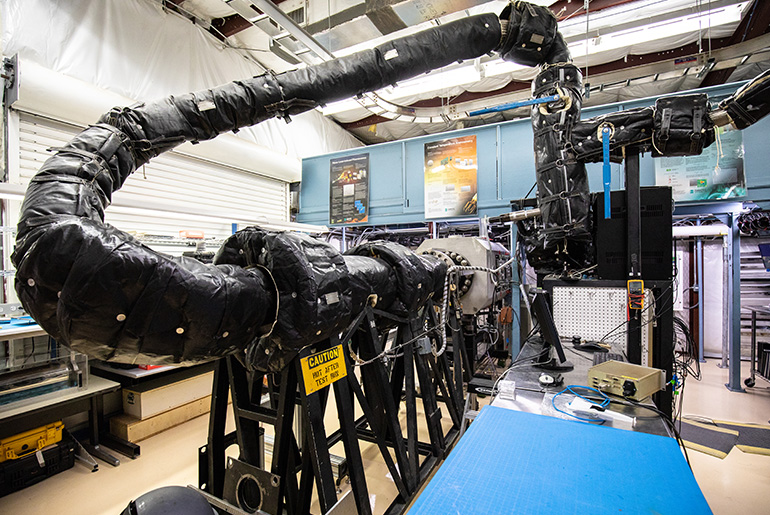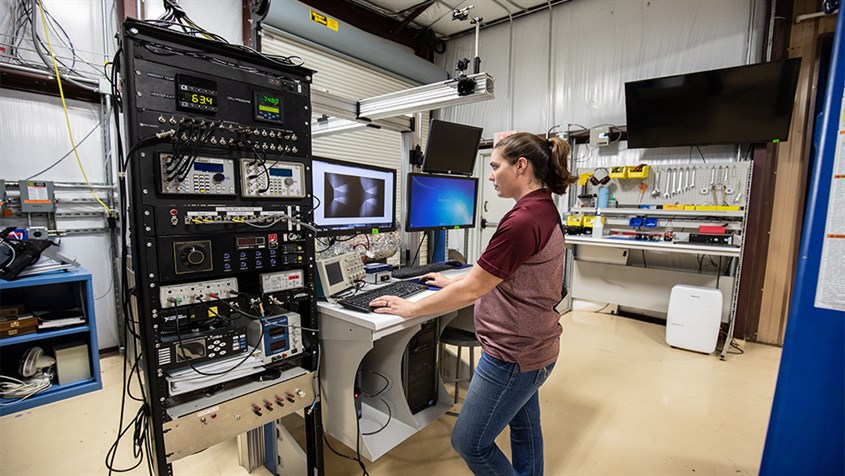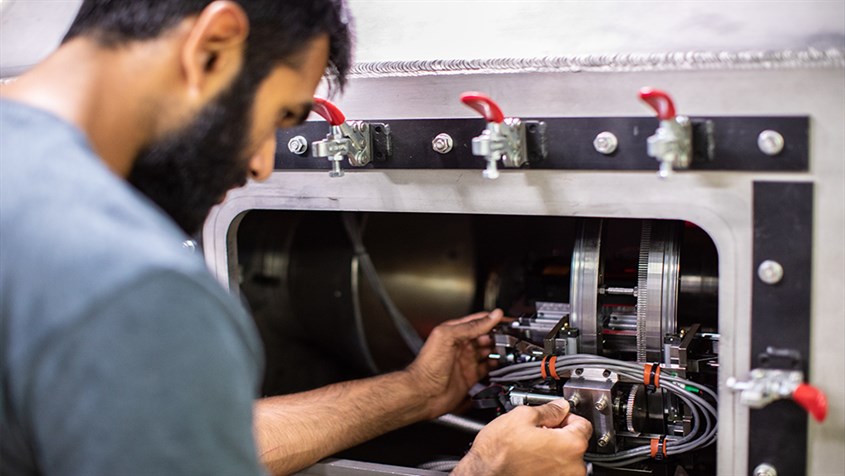
Around Mach 5, interesting things start to happen to vehicles flying in our atmosphere. It’s a harsh flight environment, and anything that can go that fast and survive is very expensive. A key challenge is that changes in the viscous flow around a vehicle can lead to catastrophic events, which are extremely complex and difficult to simulate.
That’s the challenge of the field of hypersonics, where researchers don’t have the luxury to build, flight test and retest, which is why the cutting edges in aerospace research are wind-tunnel testing and computer modeling. Armed with some of the world’s leading faculty, staff and students, as well as unique laboratory facilities, Texas A&M University’s Department of Aerospace Engineering is on the front lines of this research.
“Hypersonics is basically when vehicles are flying through the atmosphere at speeds sufficient such that the heating causes changes in the internal structure of the air molecules,” said Dr. Rodney Bowersox, department head and director of the National Aerothermochemistry and Hypersonics Laboratory (NAL). “These phenomena begin at roughly Mach 5, which is about a mile a second. As these vehicles are traveling through the atmosphere they’re creating shock waves. And as the molecules go through these shockwaves they get excited, dissociate, and chemically react.”
It’s a fair question to ask why even travel at hypersonic speeds, and Bowersox admits that civilian aircraft traveling at these speeds may be a dream (though companies such as Boeing seem to share this dream).
However, it’s already a current reality for space exploration, space planes, and national security. Earth’s gravity pulls back any vehicles reentering the atmosphere from space at hypersonic speeds, and recent tests of hypersonic vehicles by potential adversaries underscore the national security motivation.

The most well known issue of travelling at hypersonic speeds is surface heating. “For example, a turbulent flow can produce six times the heating of a laminar flow and if unexpected, could mean the loss of the vehicle,” said Dr. Helen Reed, director of the Computational Stability and Transition Laboratory. “Computational research coupled with data from tests with models studied in our quiet tunnel will lead to a better understanding of when and why the air flowing over a surface changes (transitions) from smooth to turbulent, and we observe a strong increase in heating and drag. Predicting and controlling the transition process are recognized as critical enablers for future hypersonic systems, and engineers need highly accurate predictive tools for confidence in their designs. For example, designs with extended regions of laminar flow would heat up less, thus requiring less heat shielding and likely lighter-mass vehicles.”
Being able to build a computer model for this process is extremely complicated, but Reed is an internationally acclaimed computationalist and has developed state-of-the-art tools and theories to predict airflows.
“To do a flight test is extremely expensive and with the harsh environment it is very challenging to take the right measurements to confirm that you got things right,” said Reed. “But with our suite of ground test and computational facilities, and by working as a team on these problems, our goal is to predict the flow field and heating, measure it, figure out and model the right physics, and then those models can be applied to design the flight articles. We’ll give our models to those that are building these vehicles and they’ll be more reliable in helping them achieve successful missions.”
Building the right kind of lab facilities is crucial for any research, but hypersonics offers many critical challenges. “For example, most conventional wind tunnels inherently have disturbances and noise levels that are many times greater than the relatively undisturbed (or ‘quiet’) atmosphere encountered by a flight vehicle. Even seemingly small effects can be highly amplified and can give results different than what is observed in flight for some technologies. Texas A&M has two signature facilities whose flowfields have been especially conditioned to mimic the ‘quiet’ flight environment: one is low-speed (Klebanoff-Saric Wind Tunnel) and one is hypersonic (Mach 6 Quiet Tunnel),” Reed said. The Mach 6 Quiet Tunnel from NASA is one of only two in the United States and is now housed within the Texas A&M NAL. Creating and maintaining these types of tunnels is difficult, so much so that the tunnels themselves are research projects.
Bowersox, along with Dr. Simon North (professor and head of the Department of Chemistry at Texas A&M), and their team have created additional complementary signature facilities and capabilities, including a high-temperature shock driven facility capable of producing Mach 15 flight conditions within the NAL, all of which are critical to advancing hypersonics. Bowersox is an internationally recognized experimentalist, having established programs in next generation propulsion systems, turbulent flow modeling, high-temperature chemistry effects and diagnostics.
The extensive faculty expertise also includes Dr. Richard Miles, who recently joined the Texas A&M aerospace department as part of both the Chancellor’s Research Initiative and Governor’s University Research Initiative programs. Miles is a world-renowned leader in developing new advanced laser diagnostics, and he is creating a new laboratory to be located next to the NAL to pursue the study of aerospace applications of lasers and electromagnetics. According to Bowersox, Miles’ innovative measurement techniques are enabling new measurements in hypersonics at research facilities across the U.S. In addition, Dr. William Saric, an internationally renowned expert in boundary layer stability, led a five-year Air Force and NASA-sponsored center in hypersonic transition. The Mach 6 Quiet Tunnel was an experimental centerpiece of this program.
Miles said the challenge of hypersonics has been a recurring theme ever since his first experiments with hypersonic helium at Princeton University in the 1970s, and that it was clear even then that lasers could provide critical measurements that otherwise were not possible with conventional methods in hypersonic flows. Miles and Bowersox met previously while working on the National Aerospace Plane project and then again when they were part of the Defense Advanced Research Project Agency Quiet Supersonic Platform, which also included Reed, who was at Arizona State University at the time.
“Since then it seems that all hypersonic roads now converge on Texas A&M, at least in the academic domain,” Miles said. “Rodney and Helen have built a unique capability and assembled an outstanding team of researchers. The commitment that Texas A&M has made to hypersonics is remarkable. The NAL not only has unique wind tunnels, it also leads in the development and application of advanced diagnostics. Once I became emeritus at Princeton, the opportunity to join the Texas A&M team became a reality and it is proving to be a wonderful transition.”
According to Bowersox, “A key strength of the Texas A&M program is the excellent cross-discipline faculty from aerospace engineering, chemistry, physics, materials science and engineering, and mechanical engineering.”

Student Impact
The outstanding faculty and laboratories within the department have made Texas A&M an exciting destination for students interested in aerospace fields.
The quality of the students in the program became apparent last year when the Texas A&M sounding rocketry team, which was a spin-off of Bowersox’s laboratory, competed for the first time and placed second in a national competition in New Mexico despite not being able to launch the rocket due to a sensor malfunction.
Evan Marcotte, a former student who now works with Blue Origin, an aerospace manufacturer based out of Washington, helped start the team a few years ago because he had a hard time getting internships with companies because he didn’t have any hands-on rocket experience.
“I think that continued legacy from one student to another is what allows a culture to thrive and grow,” he said. “I truly believe that the NAL is one of the most unique places in the academic world due to the students who go through there and Dr. Bowersox’s leadership. I have no doubt that it will continue to produce top-notch students and do some amazing things.”
Marcotte also said that the way Bowersox leads the lab is the key to its success.
“He guides and defines big picture plans but allows students to truly take ownership of their projects, from design and fabrication to data acquisition and analysis,” he said. “He maintains the perfect balance between being there and not, to the point where you can make mistakes and learn, but always know that if you hit a wall that he is there to help you overcome it.”
Similarly, Reed has created the AggieSat Lab student satellite program, which has launched four student-developed satellites into orbit. The mission of AggieSat Lab is to provide students with real systems engineering and leadership experiences, develop and demonstrate modern technologies using a small-satellite platform, complement students’ in-class education and teach industry practices, all as extracurricular activities.
Bowersox said that another interesting aspect of hypersonics research is that since being able to test and observe some aspects of it is still such a new field, there are unique moments. “You may make a measurement and you’ll see it, and sometimes you’ll be the first person to ever to see it,” he said. “Maybe it’s a fluctuation somewhere. Even if it’s a small thing, it doesn’t matter. Students love the science aspect of what we’re doing.”
“The students in our department believe in the future of high-speed flight, rockets and space exploration, and being a part of enabling humans to achieve these goals,” said Reed. “They closely follow international progress, and with their passion and capabilities, they will be the leaders, the enablers.”
With the quality of research going on with the faculty and students, it’s a good bet that Texas A&M’s hypersonics program will be involved in helping humans travel faster and farther for years to come.
